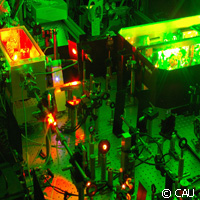New techniques set stage for ultra-fast nanophotography
Processes at the atomic level are not only miniscule; they are often extremely fast and therefore, difficult to capture in action. But now, in the journal Nature, German scientists together with US colleagues present techniques that take us a good step closer to producing an 'atomic movie'. Specifically, they were able to record pictures at such a short time interval that it is possible to observe atoms and nanostructures in real time. The 'atomic movie' that shows how atoms behave at the crucial moment of a chemical reaction would help us understand processes that are only one femtosecond long (a femtosecond is a millionth of a billionth of a second). EU support for the work came from the X-RAY PUMP-PROBE ('X-ray pump-probe spectroscopies - New tools to study ultrafast surface dynamics') project, which received a Marie Curie International Outgoing Grant worth nearly EUR 160,000 under the Seventh Framework Programme. The traditional optical microscopes that are widely used to bring small things into focus have a basic problem when it comes to resolving something as small as an atom. The best that such microscopy can do is to resolve objects about 200 nm wide - almost three orders of magnitude larger than the diameter of an atom. In order to get closer to imaging on atomic length scales, a radically different approach is required, with the first step being to reduce the wavelength of light. The wavelength of a photon of visible light is huge on the atomic scale. Visible light spans from about 400 nanometres (nm) to 750 nm, and there is a fundamental limit - the so-called diffraction limit - that dictates just how small an object can be resolved using photons of these wavelengths. X-rays are needed to reach nanometre and sub-nanometre resolution, and there have been dramatic and impressive breakthroughs in the resolving power of X-ray microscopy in the recent years. The University of Kiel scientists used ultra short flashes of light in the soft X-ray spectral region generated with a laser system. Professor Michael Bauer of the University of Kiel explains: 'the techniques that we have developed enables us to record films of extremely fast processes in a much more comprehensive manner than ... was previously possible with similar techniques'. 'We are able to directly track phase transitions in solids or catalytic reactions on surfaces,' adds Professor Bauer. These occur when, for example, atoms and molecules react with one another or when the states of electronic components change. Such processes take place on time scales of femtoseconds. 'The amount of information gained from our pictures when played back in slow motion is vast,' concludes Professor Bauer. 'We will get completely new insights into most relevant electronic properties of solids which are important for a variety of current and future technologies, for example, in telecommunications.'For more information, please visit: University of Kiel:http://www.uni-kiel.de/index-e.shtmlMarie Curie International Reintegration Grant:http://cordis.europa.eu/mariecurie-actions/irg/home.html Nature:http://www.nature.com/nature
Countries
Germany, United States



